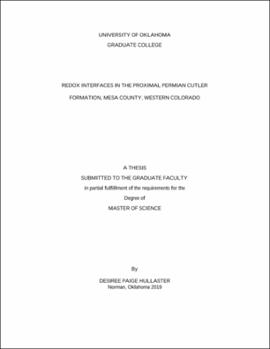| dc.description.abstract | Diagenetic and hydrothermal fluid alteration of ancient sedimentary rocks create visible ferrous (green)/ferric (red) redox interfaces attributable to changes in iron oxide and phyllosilicate mineralogy. Redox interfaces control aqueous/ solid phase partitioning of metals such as uranium. However, the long-term implications of ancient redox interfaces for the immobilization of metals in reduced, green siliciclastic rocks interfingered and layered between Permian red beds remains uncertain. We investigated redox interfaces of early Permian sediments in contact with Precambrian basement rock to understand how red bed mineralogy impacts metal reactivity during hydrothermal events. The proximal Cutler Formation onlaps Precambrian crystalline basement at the mouth of Unaweep Canyon in western Colorado and hosts dark green coarse-grained Cutler rocks in direct contact with basement rock and mint green, reduced, primarily coarse-grained intervals within red bed siliciclastic strata above the basement contact. The more western portion of the proximal Cutler additionally hosts bleached-mint green layers within red beds. We hypothesized that color variations resulted from grain-size variations that regulated flow of reducing fluids during the Tertiary hydrothermal event in the nearby La Sal mountains. Powder x-ray diffraction (XRD), scanning electron microscopy (SEM), and energy-dispersive x-ray spectroscopy (EDS) revealed the presence of hematite and chlorite in both red and green sediments, but no iron oxide occurs in the bleached sediments. Pervasive hematite in both red and green layers suggests that sediments were hematite-rich before hydrothermal alteration. Abundant mixed layer and swelling clays such as smectite, illite-smectite, and chlorite-smectite (or corrensite) dominate the mineralogy of the clay fraction. Previous studies indicated the presence of kaolinite; however, it is absent in our samples. Optical microscopy and electron microbeam analyses were performed to identify biotite-fluid reactivity, especially in association with chloritization, but also with authigenic mineral formations in association with hydrothermal fluid alteration. Furthermore, quantitative comparison of grain sizes in red, green, and bleached (RGB) intervals were performed via laser particle size analysis (LPSA) and demonstrates that the red intervals are finer grained than the green and bleached intervals. Ultimately, understanding the reactivity of redox interfaces in ancient sedimentary rocks will help predict the behavior of redox-active metals such as U(VI) and the long-term persistence of sedimentary rock reducing capacity for metal immobilization. | en_US |
